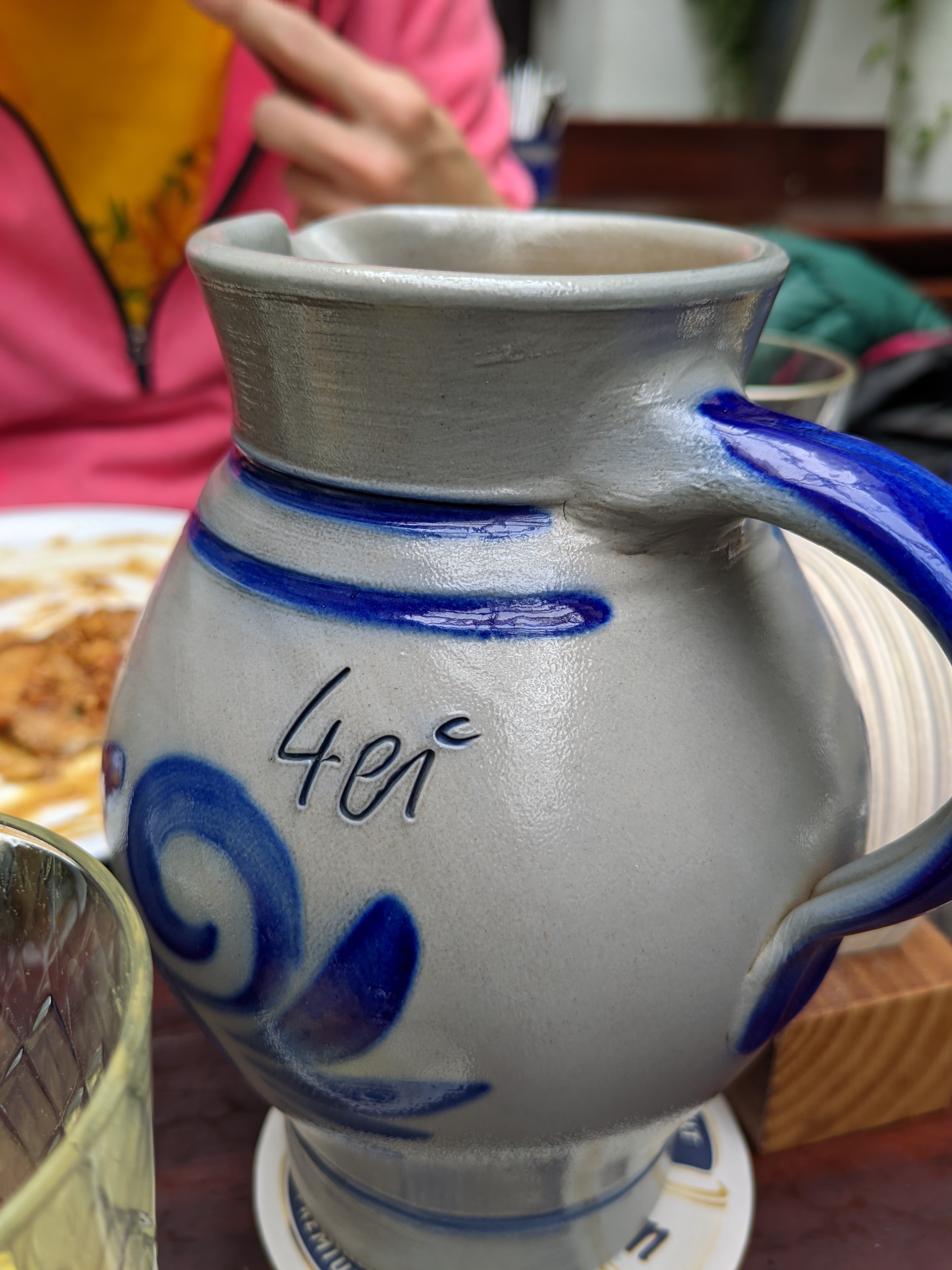Sigh. Always test cast iron of unknown history. Any wall mounting tips lol?
a lot of lead tests are unreliable, keep that in mind
An shit, I’ve never tested my thrifted pans…
I’ve never even considered this as a potential history for a used pan. Thanks for the post.
Yeah this one is a heads up - I’ve always thrifted and sourced my pans at flea markets. I would imagine that sandblasting the pan and re seasoning might mitigate?
Wouldn’t sandblasting aerosolize the lead?
Probably, but you should be wearing PPE anyway. And washing your hands like it has lead, even if it doesnt.
Generally microscopic particles of silica, metals, paints, oxides, etc
My point is it would spread the contamination around. RIP sandblasting place, no? All the objects around, would all receive a thin veneer of lead.
not all sandblasting is ghost busters style though. Plenty of smaller units in use that have some pretty extensive filtration add’ons for just this type of situation (think sci-fi medical glass-box with glove inserts you stick you hands into and where the alien eventually breaks out of).
Thank you for the explanation and the mental imagery. I’m a big Alien fan.
Depends if the lead is just a later contamination on the surface or is already in the material since the beginning. For first one your idea might work, second one definitely not.
I think no, but I’m not an expert here. I can find no articles with a statement for or against that aren’t opinion pieces or reddit threads.
I’d err on the side of caution but this would be a good experiment and follow up video on YT
Someone used it for making bullets. Selling it without disclosure was quite irresponsible of them.
It could have been an estate sale and changed hands a couple times, considering how old these are
I would still clearly mark any cast iron that I used to melt metals.
how? what methods don’t just wash off?
A stamp on the cooking surface is one way I’ve commonly seen it done.
Gouge It with a steel tool.
LASERS!!!
I imagine at a high enough temperature, alloys of lead and iron are formed. Little crystals of lead may sit within the iron, which likely doesn’t melt but might allow some lead in. Still, it’d probably be metallic lead rather than the much more bioavailable ionic (salt) form, but I still wouldn’t use it for cooking. Props to OP for testing it.
If you use a test on a pan that is known to have not have been exposed to lead, is it still positive? I’ve heard that some of these tests are designed to give false positives so that they do not give false negatives, but I do not have a source for that and it would be bad to assume it to be true without evidence.
Yes I did test against known pans and it came up negative :/
You should somehow permanently mark it so someone unfamiliar with your test doesn’t try to use it for food
Drill a hole in it
Oof, that’s commitment.
Cast is some hard shit… Drilling it sucks.
Just put it in the dishwasher then.
That’s a sin! The goal is to leave it presentable, as a decoration but ensure no one puts food in it
Cast is brittle. It drills super easy. I’ve had 2x4 from homedepot give me a harder time. Just lean on drill to give it that umph.
Low speed
High feed
Get those chips outta there!
then how would you use it for melting more metal?
A hacksaw score across the handle?
Is there no way to get rid of the lead?
My question is really academic - literally. I’m curious about the physics/chemistry of what happens when lead is melted in cast iron.
If a pan tests positive, seems safer bet to retire it - pans are cheap compared to your health.
Chemistry instructor here. It depends on how hot you get the pan. For the most part, the lead is going to stay in the seasoning, like someone mentioned above. However, if it got anywhere close to the melting point of the iron, you could wind up incorporating some of the lead into the iron itself. This seems pretty unlikely, as lead melts at about 325oC and iron melts above 1,500oC, but it’s possible as natural gas and propane burners can get up to above 1,900oC
I’d hope they weren’t cooking it until it was glowing bright white hot.
Me too, but since we don’t know exactly why they were melting lead or what other metals might have been mixed it, it’s impossible to say for sure.
Lol I’d would love to see home attempts to even try to get it to that temperature. But I would also like to be far far away. Because at those temps if the sounding area isn’t sufficiently prepared for metal casting. Anything is a bomb. Even the dirt and concrete.
In my experience, people get really creative when it comes to kitchen/garage chemistry, so all I’m saying is I wouldn’t rule out anything that is physically possible.
Especially if we’re talking about one’s personal health.
Edit: since it’s relevant, I literally just taught a lab section that has a research project component, and one group did their project on metallurgy. They were able to use butane Bunsen burner attachments and cinder blocks to make a furnace that was able to melt iron and make some mediocre steel alloys using only stuff you can buy at Home Depot.
Cinderblocks? At those temps? That’s very dangerous. Cinderblocks can explode at those temperatures due to trapped moisture in the pores. Also, it can crumble apart and spill whatever is in the pot, granted if you guys are using cinderblocks for this… i doubt that the area is prepared accordingly. So when the hot liquid metal hits the ground, it will cause it to also explode from moisture, launching blobs of hot metal everywhere.
They fired the cinder blocks to temperature without any metal just to test them and did go through several before they got a number that could be repeatedly heated to temp without crumbling or exploding. They used proper PPE the whole time with professional supervision. edit: also, they were using the cinderblocks as the enclosure, not to support the crucible. they used ceramic alumina rods and stands like those used in pottery kilns for the stands and supports.
Again, you’re missing the point. The point is people get really fucking creative and don’t necessarily let the danger stop them from doing something. So I wouldn’t bet my health that OOP’s pan isn’t contaminated beyond the seasoning.
Nah wasn’t missing the point, I just don’t want any fucking creative people/ hobbyist reading that they can go to home depot and make a smelter in their back yard by just by staking some cinder blocks and a rosebud torch on butane. To many folks, take what they read as flat out gospel these days and don’t do the due diligance to look further.
The pan it’s self though it’s garbage. The value of it vs the risk to personal health. Nah. Realy at end of the day what do you get after all that work to clean it a piece of cast iron that fries food the same as another cast iron? And a cool story about how you had to clean the lead of that pan before it was “safe to eat” lol
I’d wager it’s mostly surface contamination, so maybe but it’s not worth it - assuming you can even safely remove the lead without contaminating everything around you, you now have a bunch of lead to dispose of.
Once that’s done and you have a pan with “undetectable levels” of lead do you even trust it knowing the pan’s history?
Its a lot of tools, time, and testing, when you could just go buy an uncontaminated pan and move on.
This is something I would expect a chemistry type content creator like codyslab, nilered/blue, or E&I to do just to demonstrate how feasible it is.
With a cost breakdown and showing what chemical waste remains after the fact, it would be super obvious it’s not worth it unless you have some sentimental attachment to it, like it was your great grandparents pan or something.
oh god, don’t tell Nilered. He’ll end up melting down hundreds of cast iron trying to get enough lead to make something with lol.
seriously though, whoever does it I hope they find some older ones to test as well and not just trying to replicate it with melting metals. Might be like trying to find a 4-leaf clover and they would be getting tons of people just shipping pans but I think it would be important to see the effects time had. Full testing including cutting open and seeing the results in the layers below the surface if they’re trying to remove it.
Holy shot never thought to test used cast iron of unknown provenance.
You can def strip it, the lead contamination is in the seasoning but it’s not gonna get into the iron. Buuuut sanding that down will be a hazmat zone. I’d bunny suit/sealed goggles/P100/sand on plastic sheet cause that’s gonna be the worst case for lead dust. Idk if it’s worth it.
Check flurospec if you have some extra disposable cash for better lead tests https://www.detectlead.com/, I wonder if the types of tests you used turned red due to interacting with iron or something (unlikely but possible, they incorrectly react sometimes and it’s red so monk brain wonders…)
Oven cleaner will strip seasoning
Just be sure to put a label on the back stating it should not be used and contains lead. You never know who may attempt to use it someday for whatever reason. Also, in case something happens to you and someone cleans out your place, they will know its deadly and should discard it instead of keeping it.
Why not break it and throw it away?
The norm where I’m from is to drill a hole in the bottom so it becomes useless.
The best idea ive read.
Until someone fills the hole with a little lead. Good as new!
You can lead a horse to water
Shoot it with more lead
Sounds like a job for a paint pen.
Melt some PET water/soda bottles (e.g. with a heat gun) so the plastic drips on to the bottom side and scratch out a huge ass warning into it with a hobby knife (or any knife, really… It’s just PET). Also write another warning with a sharpie in multiple locations.
Why this method? Because that plastic will stick pretty good to the bottom of a cast iron pan—making anyone thinking of using it think twice, “How TF am I going to get that off without making a gross burning plastic stink?” Or a fool will try and quickly get annoyed that it won’t sit flat on their stovetop and it’ll be too far away from an induction heater to work. Make the plastic nice and uneven 👍
Also, if you’re just hanging it up on the wall no one will see the bottom so it won’t uglify your pretty hanging pan.
Melting a water bottle with a heat gun happens pretty fast and the iron pan will absorb the heat in the plastic quickly too. So the whole process will take less than a minute. Then scratching out a warning label will take a few minutes 😁
Dremel tool with a diamond bit. Carve “LEAD” on the bottom.
I mean… A hammer works pretty well, too.
Make it an art piece.
Broken Dreams, 2025
Have you tried to break a cast iron pan with a “hammer”?
At a minimum it’ll take a sledge, and that will still take a bit of effort.
Besides, it’s just no longer useful for food. Still fine as decoration, door stop, anchor - whatever you can think up.
A big painted “Not food safe” on the back would be a good reminder.
Yes, I have, and the first time was by accident because I figured “it’s metal, metal is hard to break”
After reading some of this thread, I have decided if someone wants to gift me cast iron and it’s bad, from now on I’m gonna use some of my metalworking tools to engrave a pattern into it.
A big NOT FOR FOOD engraved on the back would be a good addition just in case someone decides it’s decorational engraving and still usable. Maybe even a little periodic table square for lead engraved on it somewhere as well.
I like the way you think!
I wonder if you tried the electrolysis trick to remove all of the coating and then tested the bare metal if it would still have lead contamination.
If the coating contains lead and you get rid of it, and then the bare metal doesn’t, then you could just re-season the pan and it would be fine, right?
Can I ask where you got the lead testing swabs (brand/part number)? I’d like to test some of my cast iron.
I got a similar kit on Amazon a while back Webetop lead testing kit
is this common with old cast iron?
Cast iron can be used for melting lead to form shot and fishing weights. That’s rare now but did happen
Actually when I was a kid, one year my Dad melted metal for weighting my pinewood derby - I do wonder now what he melted and how. Not many easily obtained metals are heavy and have a low melting point
It was most likely lead. It was also used as weights for fishing lures and a ton of other stuff.
I melted metal for my kids’ cars. It isn’t hard to find a low melting point allow that is safe as well (well as safe as a low melting temperature alloy can be…)
It could’ve been pewter. You can melt that in a pan on the stovetop. 170-230°C is all it takes and your typical electric stovetop can get up to 800-900°C.
I see a reference to lead being removed from pewter “in the 1970s”, and yes, I’m old enough that lead is still in question
Pewter contains Antimony, which is still toxic. It used to be made into cups to induce vomiting.
Not really. Though sometimes people do use the pans for weird shit and they can get contaminated that way. One example I heard was of people melting lead for fishing weights and bullets (though your cast pan would have to be really old if it was used for that).
Not necessarily. People still scavenge lead (often from car batteries) and cast their own fishing weights and bullets.
Not that it’s a cast iron level of this issue, but I knew a guy who paid for college (this woud have been about 10 years ago now) by purchasing scavenged and derelict boats, then chopping\melting the lead ballast out of them to resell as raw metal. Never underestimate the value of scrap metal or people’s willingness to gather it up for money.
There is a multi billion dollar industry revolving around scrap metals.
Oh no! I will have to test the ones that I have, especially the inherited one.
Wall mounting tip: Hooks on a sturdy board (maybe hardwood like oak) that spans several studs should be sufficient.
Well, what can I do for ye?













